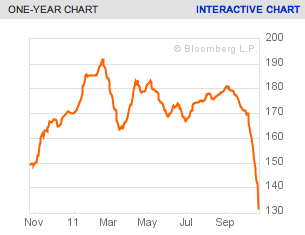Iron ore is crashing. Overnight the price fell 7% plus to $131.70:

Thankfully, 12 month swaps only fell 1% to a new low of $117. Shanghai rebar was also flat on the day.
But, as China iron ore port stocks show, there’s plenty in reserve if the draw down continues:

So, there’s some inconsistency here. Obviously rebar looks to be holding up better (down only 18%) than iron ore (down 30%), suggesting oversupply in the latter. And, from Reuters, that’s what we find:
World No. 2 iron ore producer Rio Tinto on Tuesday blamed Vale for sharply falling spot prices of the steelmaking raw material, saying its bigger rival is diverting European shipments to China.
The move by Vale had not caused Rio to stop running its own iron ore mines at full capacity, Rio’s iron ore division head and Australian chief executive Sam Walsh said.
“My business is shipping flat out,” Walsh told a business forum in Perth on Tuesday. “We are producing at record rates.”
Spot iron ore prices have shed 19 percent so far this month in a sell-off largely fueled by slower construction steel demand in China, the world’s biggest buyer of imported iron ore at around 400 million tonnes a year.
In Europe, a more important market for Vale than Rio, steel markets have taken a knock given uncertainty surrounding the region’s debt crisis.
Growth of Europe’s steel production will slow in 2012 along with activity in the steel-using sectors, Eurofer, the European steel producers association, has forecast.
Spot iron ore prices on Tuesday fell nearly 4 percent. It was the biggest single-day drop since August 2009 as thin demand from China forced some traders to sell at a loss.
“Traders who can’t hold positions because they don’t have sufficient funding are selling at a loss of $40-$45 a tonne,” said a Singapore-based iron ore trader.
Despite price falls, all three mega-producers including Rio are ramping up production, with Walsh downplaying the lasting effect of Vale’s strategy.
“There’s a limit to what they can physically ship,” Walsh later told Reuters on the sidelines of the forum. “We’re not overly concerned about that.”
He said Rio remains confident in the long-term drivers of economic growth and iron ore demand in China.
“The issue is contagion. It’s perception, it’s fears,” he said. “When you look at the fundamentals of China, India, South Asia, North Asia, we find it’s very robust.”
And so what? Since when was iron ore a regional market? I’m wondering how long it will take Rio to stop saying that they’re producing flat out, that doesn’t look so hot in a competitive market.
It seems Australia is suddenly much more exposed to Europe than pundits thought. And it will get worse before it gets better with the Continent only now tipping into recession, not yet embarked on its version of the inventory cycle.
But according to the FT, there is also a Chinese angle:
The production cuts at small and medium-sized Chinese steel mills present fresh evidence that Beijing’s monetary tightening is filtering down into slowing demand for raw materials. Although China’s steel demand outlook has not changed in recent weeks, traders and executives say financing has dried up for some mills, prompting them to cut output and reduce ore purchases.
“Around 20 to 30 per cent of the small and medium mills in this area have shut down their furnaces,” said a steel executive in southern China. “Our mill hasn’t reduced production yet, but we feel the pressure of reduced liquidity. When we make sales, the cash comes back slower and slower. Liquidity is a big concern.”
One trader in the steel town of Rizhao added that some mills had brand new furnaces idled. “They don’t want to produce because they will just lose money.”
…Consultancy MySteel estimates that 5 per cent of China steel production has been taken offline in recent weeks. The small steel mills cutting their production typically buy iron ore on the spot market, largely from Indian miners, so their absence can cause spot prices to fall disproportionally. Larger steel mills, which buy their raw materials from bigger miners, are still going strong, traders said, although some have announced maintenance-related production cuts.
The construction sector, a major source of steel demand, has slowed this year as Beijing has tried to cool real estate prices. Over the past year China has raised interest rates and bank reserve requirements in an effort to fight inflation, and these measures have restricted the flow of credit into the economy.
My bet is coking coal will follow, though perhaps not so far. At some point, something will stop and reverse the falls, perhaps anticipation of a Chinese stimulus by year end, but with Europe likely to deteriorate, that may not be enough to bounce the price very far.
What I can say is that if current prices are sustained for any period, as the IMF recently made clear, we are facing a terms of trade shock and recession next year.

